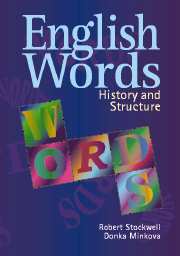Book contents
- Frontmatter
- Contents
- An introduction to the textbook
- Chapter One Word origins
- Chapter Two The background of English
- Chapter Three Composition of the Early Modern and Modern English vocabulary
- Chapter Four Smaller than words: morphemes and types of morphemes
- Chapter Five Allomorphy, phonetics, and affixation
- Chapter Six Replacement rules
- Chapter Seven Deletion rules and other kinds of allomorphy
- Chapter Eight Fossilized allomorphy: false cognates and other etymological pitfalls
- Chapter Nine Semantic change and semantic guesswork
- Chapter 10 The pronunciation of classical words in English
- Appendix I An introduction to dictionaries
- Appendix II Morpheme list
- Index
Chapter Seven - Deletion rules and other kinds of allomorphy
Published online by Cambridge University Press: 05 September 2012
- Frontmatter
- Contents
- An introduction to the textbook
- Chapter One Word origins
- Chapter Two The background of English
- Chapter Three Composition of the Early Modern and Modern English vocabulary
- Chapter Four Smaller than words: morphemes and types of morphemes
- Chapter Five Allomorphy, phonetics, and affixation
- Chapter Six Replacement rules
- Chapter Seven Deletion rules and other kinds of allomorphy
- Chapter Eight Fossilized allomorphy: false cognates and other etymological pitfalls
- Chapter Nine Semantic change and semantic guesswork
- Chapter 10 The pronunciation of classical words in English
- Appendix I An introduction to dictionaries
- Appendix II Morpheme list
- Index
Summary
This chapter turns to deletion rules, as well as other kinds of allomorphy, some of which can be recovered only historically. The first set of changes to be considered produces allomorphic variation due to the dropping of one or more phonemes from the edges of the original forms of roots or affixes. Like replacement rules, deletion rules must be defined in terms of both the phonological environment and the type, position, and number of morphemes involved in the change.
Consonant deletion
No double consonants. The general principle which governs the simplification of double consonants to single ones, phonetically, is that English, unlike Italian, Finnish, and many other languages, does not allow “long” or “double” consonants within a word. Our discussion of double consonant spelling in section 4.2, Chapter 6, pointed out the important distinction between double consonants in the spelling, which can arise as a consequence of total assimilation, and “long” consonants in the pronunciation. Word-internal double consonant letters are not pronounced “long”: irrational and eradicate have the same [r], symmetry and cemetery have the same [m].
English allows real long, or geminate, consonants, only at clear morpheme/word boundaries: file log, roommate, bus-schedule, bookcase, letter writer, etc. In such instances longer duration is a phonetic phenomenon only; it is unrelated to spelling. Nevertheless, there is a parallel between real long consonants and the double letters resulting from the total assimilations of Chapter 6: both are signals of morpheme boundaries.
- Type
- Chapter
- Information
- English WordsHistory and Structure, pp. 112 - 127Publisher: Cambridge University PressPrint publication year: 2001



